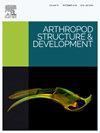海蜘蛛的雄性生殖系统(Rathke, 1799)。
IF 1.3
3区 农林科学
Q2 ENTOMOLOGY
引用次数: 0
摘要
海蜘蛛(Pycnogonida)是海洋螯合动物。碧萝丝虫是拟足角动物的姐妹分支,是比较解剖学研究的一个有趣类群,但关于碧萝丝虫的解剖学和生物学资料仍然很少。本研究在超微结构水平上详细描述了海蜘蛛的完整雄性生殖系统、配子发生和精子结构。雄性雄性生殖系统包括睾丸、股腺和外阴腺。睾丸是典型的碧萝丝虫:u形,有足部外生物,开口在2-4腿上有性腺孔。睾丸位于水平隔膜内,通过ECM与之分离。生殖窦缩小。睾丸腹壁处于萌发期,精子发生在包囊中进行,各阶段均匀分布于整个睾丸。雄性雄性精子是一种典型的在粘液中受精但没有顶体的动物精子。它缺乏非胚性的去螯合性特征,如顶体丝和着床窝。股腺和外阴腺是性别特异性的,可能与生殖有关。外阴腺可能分泌一种杀真菌物质,而股腺的功能尚不清楚。本文章由计算机程序翻译,如有差异,请以英文原文为准。
The male reproductive system of the sea spider Phoxichilidium femoratum (Rathke, 1799)
Sea spiders (Pycnogonida) are marine chelicerates. As a sister clade to Euchelicerata, Pycnogonida are an interesting group for comparative anatomy, however data on pycnogonid anatomy and biology remain scarce. This research provides a detailed account of the complete male reproductive system, gametogenesis, and sperm structure of a sea spider at the ultrastructural level. The male reproductive system of P. femoratum includes the testis, femoral, and ovigeral glands. The testis is typical of Pycnogonida: U-shaped with pedal outgrowths, opening with gonopores on legs 2–4. The testis lays within the horizontal septum, separated from it by ECM. The reproductive sinus is reduced. The ventral wall of the testis is germinative, spermatogenesis proceeds in cysts, all stages are evenly distributed throughout the whole testis. Sperm of P. femoratum is a typical sperm of animals with fertilization in mucus but without an acrosome. It lacks apomorphic euchelicerate features such as an acrosomal filament and implantation fossa. Femoral and ovigeral glands are sex-specific and likely related to reproduction. Ovigeral glands possibly secrete a fungicide substance, while the function of femoral glands remains obscure.
求助全文
通过发布文献求助,成功后即可免费获取论文全文。
去求助
来源期刊
CiteScore
3.50
自引率
10.00%
发文量
54
审稿时长
60 days
期刊介绍:
Arthropod Structure & Development is a Journal of Arthropod Structural Biology, Development, and Functional Morphology; it considers manuscripts that deal with micro- and neuroanatomy, development, biomechanics, organogenesis in particular under comparative and evolutionary aspects but not merely taxonomic papers. The aim of the journal is to publish papers in the areas of functional and comparative anatomy and development, with an emphasis on the role of cellular organization in organ function. The journal will also publish papers on organogenisis, embryonic and postembryonic development, and organ or tissue regeneration and repair. Manuscripts dealing with comparative and evolutionary aspects of microanatomy and development are encouraged.

 求助内容:
求助内容: 应助结果提醒方式:
应助结果提醒方式:


